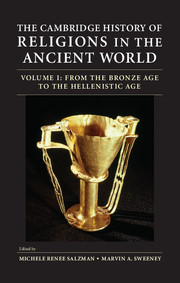Book contents
- Frontmatter
- Contents
- List of Figures and Maps
- List of Contributors
- List of Abbreviations
- Acknowledgments
- Introduction to Volumes I and II
- Introduction to Volume I
- Part I Mesopotamia and the Near East
- Part II Egypt and North Africa
- Part III Greece and the Eastern Mediterranean
- Part IV The Western Mediterranean and Europe
- Suggestions for Further Reading
- General Index
- Index of Citations
- Frontmatter
- Contents
- List of Figures and Maps
- List of Contributors
- List of Abbreviations
- Introduction to Volume II
- Part I Iran and the Near East
- Part II Egypt and North Africa
- 6 Traditional Religion in Ptolemaic and Roman Egypt
- 7 Judaism in Egypt
- 8 Ancient Egyptian Christianity
- 9 Cult and Belief in Punic and Roman Africa
- 10 Christianity in Roman Africa
- Part III Greece and Asia Minor
- Part IV Italy, Roman Gaul, and Spain
- Suggestions for Further Reading
- General Index
- Index of Citations
- References
8 - Ancient Egyptian Christianity
from Part II - Egypt and North Africa
Published online by Cambridge University Press: 05 October 2013
- Frontmatter
- Contents
- List of Figures and Maps
- List of Contributors
- List of Abbreviations
- Acknowledgments
- Introduction to Volumes I and II
- Introduction to Volume I
- Part I Mesopotamia and the Near East
- Part II Egypt and North Africa
- Part III Greece and the Eastern Mediterranean
- Part IV The Western Mediterranean and Europe
- Suggestions for Further Reading
- General Index
- Index of Citations
- Frontmatter
- Contents
- List of Figures and Maps
- List of Contributors
- List of Abbreviations
- Introduction to Volume II
- Part I Iran and the Near East
- Part II Egypt and North Africa
- 6 Traditional Religion in Ptolemaic and Roman Egypt
- 7 Judaism in Egypt
- 8 Ancient Egyptian Christianity
- 9 Cult and Belief in Punic and Roman Africa
- 10 Christianity in Roman Africa
- Part III Greece and Asia Minor
- Part IV Italy, Roman Gaul, and Spain
- Suggestions for Further Reading
- General Index
- Index of Citations
- References
Summary
More decisively than any other event in the country’s history, the surrender of Alexandria to Arab troops in November 641 marked the end of Antiquity in Egypt. Egypt was irrevocably severed from the Hellenistic world to which it had belonged culturally ever since Alexander the Great, and from the Roman empire of which it had been part politically since the reign of Augustus. Long before that crucial event, however, dramatic changes had already transformed the Egyptian landscape. In Alexandria itself around the middle of the fourth century, the Caesareum on the waterfront, completed in the time of Augustus as a temple in his honor, had been converted into the cathedral church of the city’s Christian archbishops. In the far south of the country, in Thebes, the age-old mortuary temple of Queen Hatshepsut in Deir el-Bahari experienced a different fate. In Ptolemaic and early Roman times, it had housed a thriving healing shrine patronized by the indigenous “saints” Amenhotep, son of Hapu, and Imhotep. In the third and fourth centuries of the common era, part of the temple served as a cemetery; members of the corporation of iron-workers from nearby Hermonthis used another part of the building for social and ritual gatherings, which involved, among other things, the traditional sacrifice of a donkey. At a much later stage, toward the end of the sixth century, it became the core of an impressive monastery. Dedicated to Saint Phoibammon, the monastery dominated the area until its remains were demolished by nineteenth-century archaeologists. A process of irreversible Christianization had, at an unequal pace and with different outcomes, affected both the centers of official ceremony (like Alexandria’s Caesareum) and the shrines that served the needs of local populations (as in Deir el-Bahari).
- Type
- Chapter
- Information
- The Cambridge History of Religions in the Ancient World , pp. 211 - 234Publisher: Cambridge University PressPrint publication year: 2013



